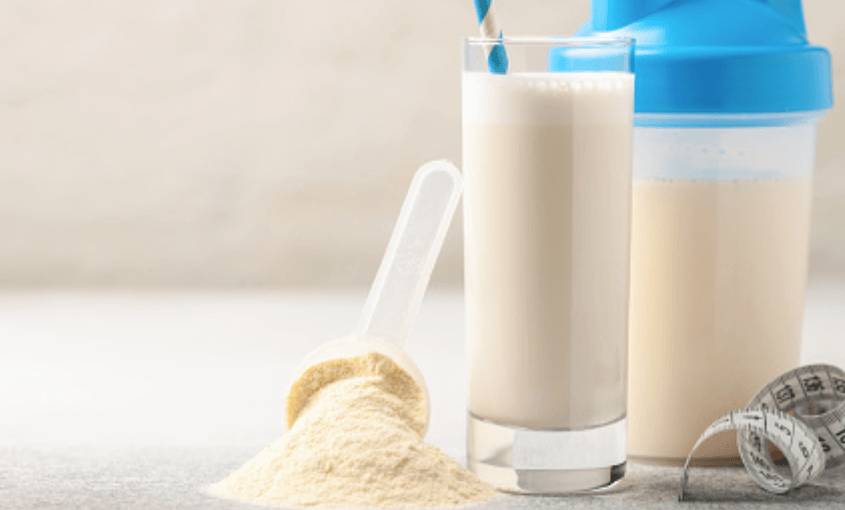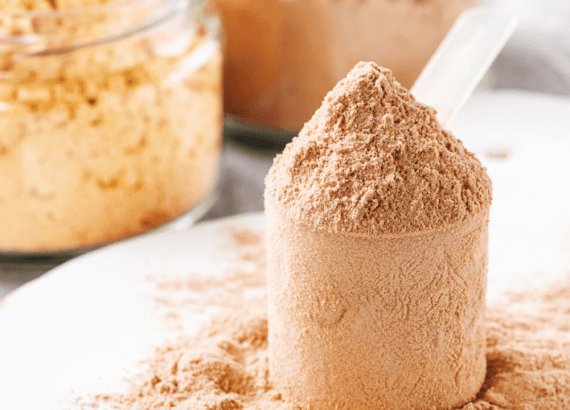How to Make Protein Powder Taste Good-Unlocking the Secrets

Protein powder has undoubtedly become an essential component for those seeking to achieve their fitness goals or maintain a healthy lifestyle.
Packed with muscle-supporting nutrients, it offers a convenient and efficient way to supplement our daily protein intake.
However, for many, the challenge lies not in the benefits it provides but in its lackluster flavor.
If you’ve ever grimaced while consuming a chalky or tasteless protein shake, you’re not alone. But don’t abandon your protein powder just yet!
In this blog post, we’ve got you covered with a treasure trove of tips and tricks that will revolutionize the way you perceive protein powder.
Prepare to unlock a world of deliciousness as we delve into creative ways how to make protein powder taste good, without compromising its nutritional value.
Whether you’re a fitness enthusiast, a smoothie lover, or simply looking to elevate your recipes, get ready to embark on a flavor-filled journey that will ensure every sip of your protein-packed concoction is a delightful treat.
Say goodbye to mundane protein shakes and hello to a palate-pleasing experience like never before!
What is Protein Powder?
Protein powder is a dietary supplement commonly used by athletes, fitness enthusiasts, and individuals looking to increase their protein intake.
It is a concentrated form of protein extracted from sources like whey, casein, soy, or plant-based proteins like peas or hemp.
Protein is an essential macronutrient that plays a crucial role in building and repairing tissues, supporting muscle growth, and maintaining health.
Protein powders provide a convenient source of high-quality protein that can be easily added to shakes, smoothies, or other recipes.
Protein powders come in various flavors and forms, such as whey protein isolate, whey protein concentrate, casein protein, or vegan protein blends.
They can be found in different ratios of protein to carbohydrates and fats, depending on the specific nutritional goals of the individual.
Types of Protein Powder
- Whey Protein: Derived from milk, whey protein is quickly absorbed by the body and is rich in essential amino acids.
- Casein Protein: Also derived from milk, casein is absorbed more slowly than whey and provides a sustained release of amino acids.
- Soy Protein: Made from soybeans, it is a good option for vegetarians and vegans.
- Pea Protein: Derived from yellow peas, it is a plant-based protein option.
- Rice Protein: Made from brown rice, it is another plant-based protein source.
Choosing the Right Protein Powder
Choosing the right protein powder depends on various factors, such as your dietary needs, preferences, and goals. Here are some considerations to keep in mind when selecting a protein powder:
Protein Source
Determine whether you prefer animal-based (whey, casein) or plant-based (soy, pea, hemp) protein powders.
Animal-based proteins are generally high in essential amino acids and easily digestible, while plant-based proteins are suitable for vegans and those with lactose intolerance.
Protein Content
Check the protein content per serving. Opt for powders with at least 20 grams of protein per serving, as this can help support muscle recovery and growth.
Ingredients
Read the ingredient list and look for protein powders with minimal additives, artificial sweeteners, or unnecessary fillers. Some individuals may also have specific dietary restrictions or allergies to consider.
Flavor and Taste
Protein powders come in a variety of flavors. Consider your taste preferences and how you plan to incorporate the powder into your diet, such as mixing it with water, or milk, or blending it into smoothies.
Purpose and Goals
If you’re looking to build muscle or enhance athletic performance, you may want to consider a protein powder with added branched-chain amino acids (BCAAs) or other performance-enhancing ingredients.
For weight management, a powder with a higher protein-to-calorie ratio may be beneficial.
Price and Value
Compare prices and consider the value based on the protein content, serving size, and overall quality of the product. Choosing a reputable brand with good reviews can also help ensure product safety and quality.
Proper Blending Techniques
Proper blending techniques can help you achieve a smooth and delicious protein shake or smoothie. Here are some tips to enhance your blending process:
- Start with liquids: Begin by adding your chosen liquid (water, milk, or juice) to the blender. This creates a base for your shake and helps the ingredients blend smoothly.
- Add protein powder: Measure the appropriate amount of protein powder according to the serving size suggested on the packaging. Add the powder to the blender.
- Add other ingredients: Depending on your preference, you can add fruits (fresh, frozen, or both), vegetables, nut kinds of butter, yogurt, or other ingredients to enhance the flavor and nutrition of your shake. Be creative and experiment with different combinations.
- Blend in stages: To avoid clumping and ensure proper blending, start by pulsing or blending at low speed for a few seconds. Gradually increase the speed and continue blending until all the ingredients are well combined and smooth. Stop occasionally to scrape down the sides of the blender if needed.
- Adjust consistency: If your shake is too thick, you can add more liquid gradually while the blender is running until you reach the desired consistency. If it’s too thin, you can add a small amount of ice, frozen fruits, or additional protein powder to thicken it.
Basic Tips for Making Protein Powder Taste Good
If you’re looking to make protein powder taste good, here are some basic tips that may help:
Experiment with Different Liquids
Instead of using plain water, try mixing your protein powder with different liquids like milk (dairy or plant-based), almond milk, coconut water, or fruit juice. The choice of liquid can significantly impact the taste of your protein shake.
Use Flavorful Ingredients
Add ingredients like fresh or frozen fruits (bananas, berries, mangoes), unsweetened cocoa powder, peanut butter, almond butter, vanilla extract, or spices like cinnamon. These ingredients can enhance the flavor of your shake and make it more enjoyable.
Consider Using a Blender
Blending your protein powder with other ingredients using a blender can help create a smoother texture and better flavor consistency. It can help break down any clumps and distribute the flavor more evenly.
Try Adding Ice or Using a Chilled Liquid
If you prefer your protein shake to be colder and refreshing, add a handful of ice cubes to the blender or use a chilled liquid.
This can make the shake more enjoyable, especially during hot weather or after a workout.
Gradually Increase the Protein Powder Amount
If you find the taste of your protein shake to be overpowering, start by using a smaller amount of protein powder and gradually increase the quantity over time as your taste buds adjust.
Opt for Flavored Protein Powders
If taste is a major concern for you, consider trying different flavored protein powders available in the market.
These powders often come in various delicious flavors like chocolate, vanilla, strawberry, or cookies and cream.
Flavor-Specific Protein Powder Tips
Here are some flavor-specific protein powder tips to enhance the taste:
Chocolate Protein Powder
- Mix chocolate protein powder with milk or almond milk for a rich and creamy chocolate milkshake.
- Add a spoonful of unsweetened cocoa powder to intensify the chocolate flavor.
- Blend with a frozen banana, peanut butter, and milk for a delicious chocolate peanut butter smoothie.
- Make a chocolate protein mug cake by combining the protein powder with a small amount of flour, sweetener, and a liquid of your choice. Microwave it for a quick and indulgent dessert.
Vanilla Protein Powder
- Blend vanilla protein powder with frozen fruits like berries, mango, or peach for a fruity vanilla smoothie.
- Add a splash of vanilla extract to enhance the vanilla flavor.
- Mix it into your coffee for a homemade vanilla latte.
- Make vanilla protein pancakes and top them with fresh fruits and a drizzle of honey for a sweet breakfast.
Strawberry Protein Powder
- Blend strawberry protein powder with milk or yogurt for a refreshing strawberry milkshake.
- Combine it with frozen strawberries and coconut water for a tropical strawberry smoothie.
- Mix it into your oatmeal along with fresh strawberries for a burst of strawberry flavor.
- Make strawberry protein popsicles by blending the powder with strawberries and a sweetener of your choice, then freezing the mixture in popsicle molds.
Cookies and Cream Protein Powder
- Blend cookies and cream protein powder with milk or a dairy-free alternative for delectable cookies and cream shakes.
- Crush some chocolate sandwich cookies and sprinkle them on top of your protein smoothie for added crunch and flavor.
- Create a cookie-inspired smoothie bowl by blending the powder with frozen bananas, cocoa powder, and a bit of milk, then topping it with crushed cookies and a drizzle of almond butter.
Creative Ways to Make Protein Powder Taste Amazing
If you’re looking for creative ways to make your protein powder taste amazing, here are some ideas to try:
- Smoothie bowls: Instead of drinking your protein shake, turn it into a delicious and visually appealing smoothie bowl. Blend your protein powder with frozen fruits, a splash of liquid, and some ice to create a thick and creamy base. Top it with additional fruits, nuts, seeds, granola, or shredded coconut for added flavor and texture.
- Protein pancakes or waffles: Add protein powder to your pancake or waffle batter for a nutritious and tasty twist. Simply mix the powder into your favorite recipe, adjusting the liquid as needed. You can also sprinkle some extra protein powder on top before flipping for an added protein boost.
- Protein-packed desserts: Incorporate protein powder into desserts like protein balls, protein bars, or homemade protein ice cream. There are numerous recipes available online that use protein powder as a key ingredient to create healthier versions of sweet treats.
- Protein-infused coffee or tea: If you enjoy a daily cup of coffee or tea, consider adding a scoop of protein powder to your warm beverage. Choose a flavor that complements the drink, such as mocha or vanilla protein powder in coffee or chai-flavored protein powder in tea.
- Protein-rich yogurt: Mix your protein powder into plain Greek yogurt to boost its protein content and create a flavored yogurt. You can also add toppings like fresh fruits, granola, nuts, or a drizzle of honey for added taste and texture.
Conclusion
Finding ways to make protein powder taste good is crucial for those who struggle with the often bland and uninspiring taste that it typically has.
By incorporating various flavoring techniques and experimenting with different ingredients, individuals can create delicious and enjoyable protein shakes or smoothies that will make their daily protein intake a much more pleasurable experience
Mastering the art of “How to Make Protein Powder Taste Good” is a game-changer for anyone looking to elevate their fitness journey.
Whether it’s adding fruits, spices, or even experimenting with different milk alternatives, there is a plethora of options available to cater to personal preferences and ensure that protein powder becomes a welcomed addition to one’s diet.
Ultimately, making protein powder taste good is not only about masking the taste but also about creating a truly enjoyable and nutritious experience.
With a little creativity and willingness to explore new flavors, anyone can overcome the taste hurdle and enjoy the benefits of a protein-rich diet.

As a dedicated medical professional with years of experience, Dr. Roksana Parveen understands the importance of taking a comprehensive approach to health and wellness. She believes in the power of education to provide evidence-based information to help individuals about their health.
More From Me
Connect with me and get latest updates. - Dr. Roksana Parveen













